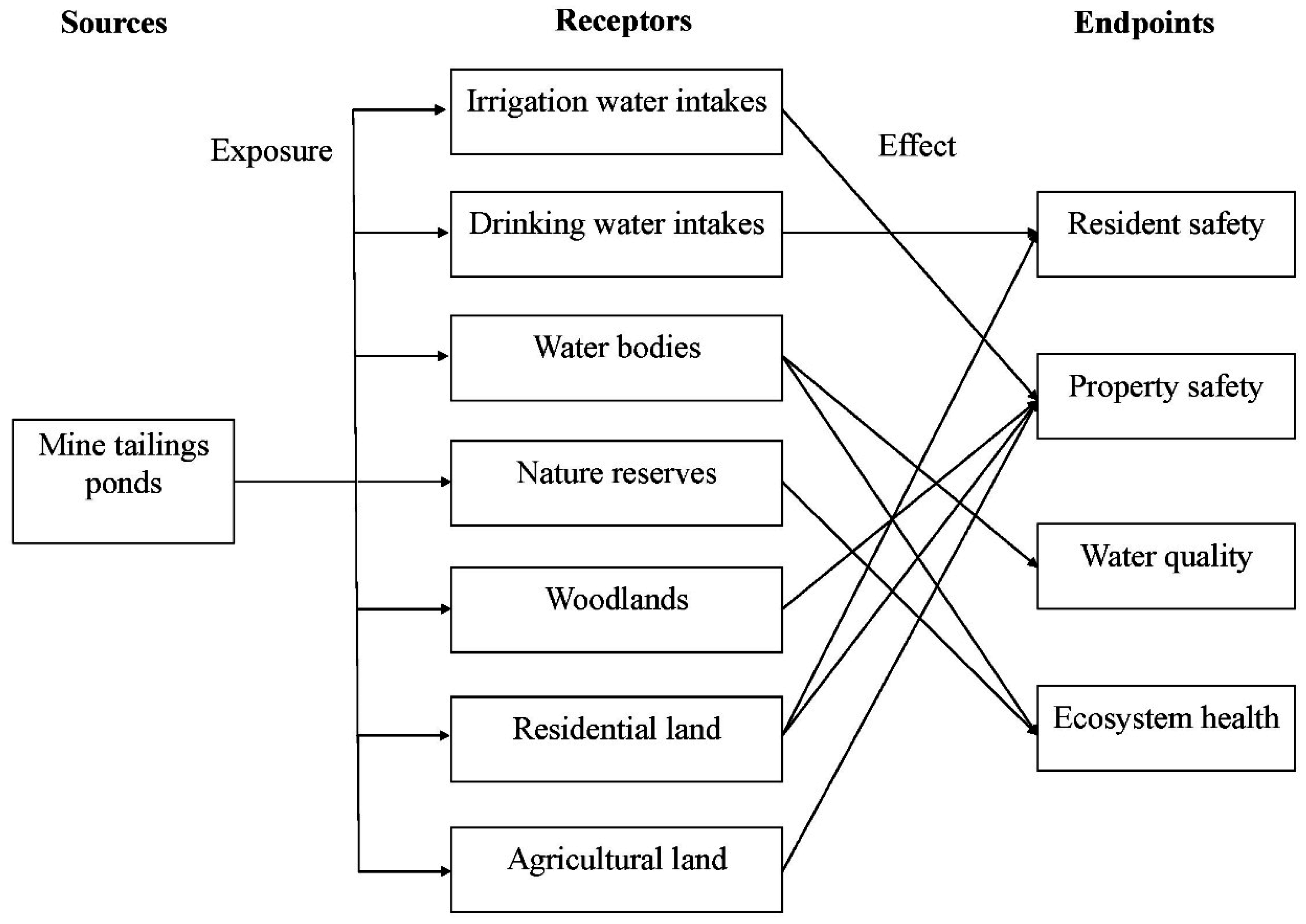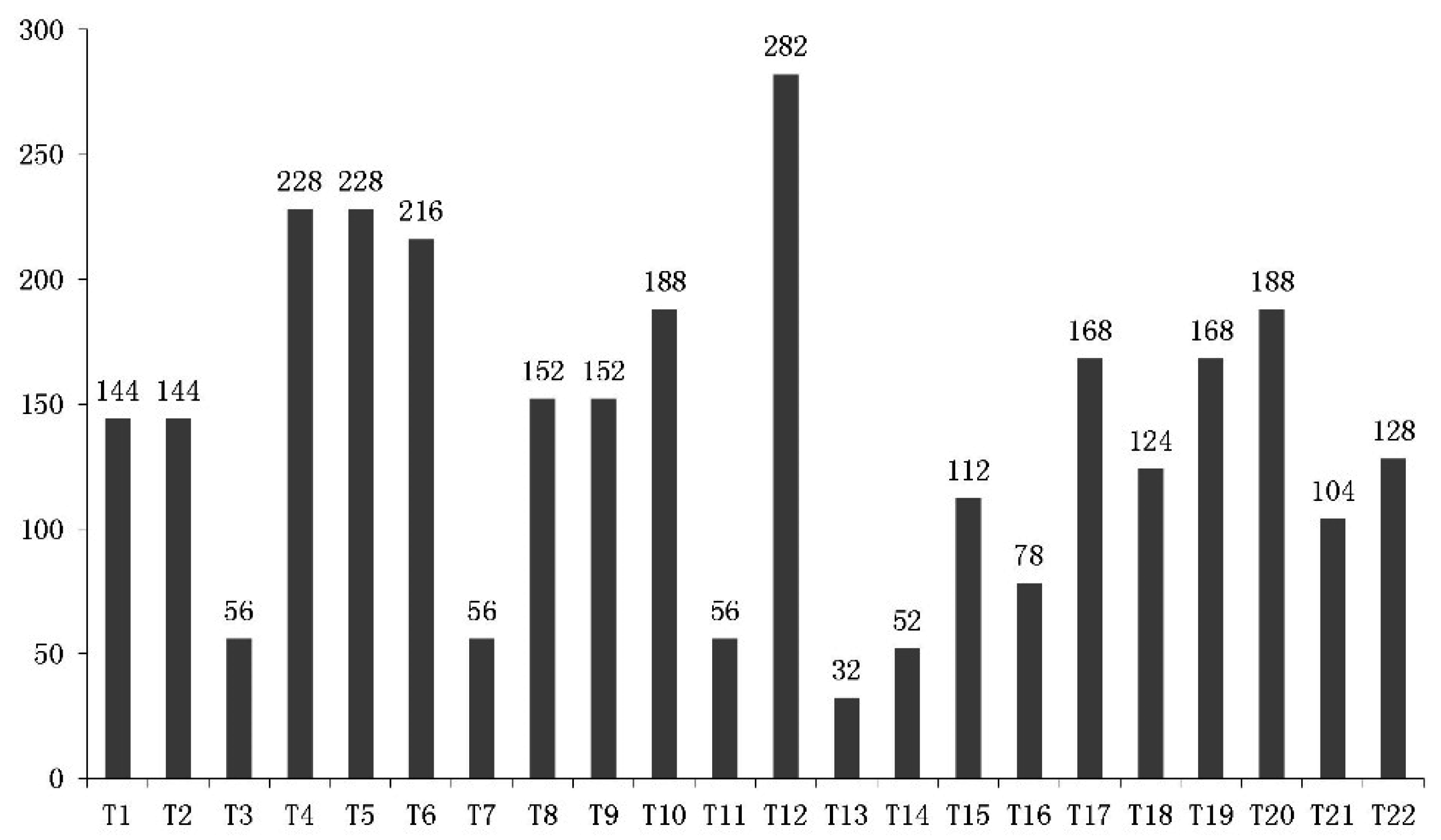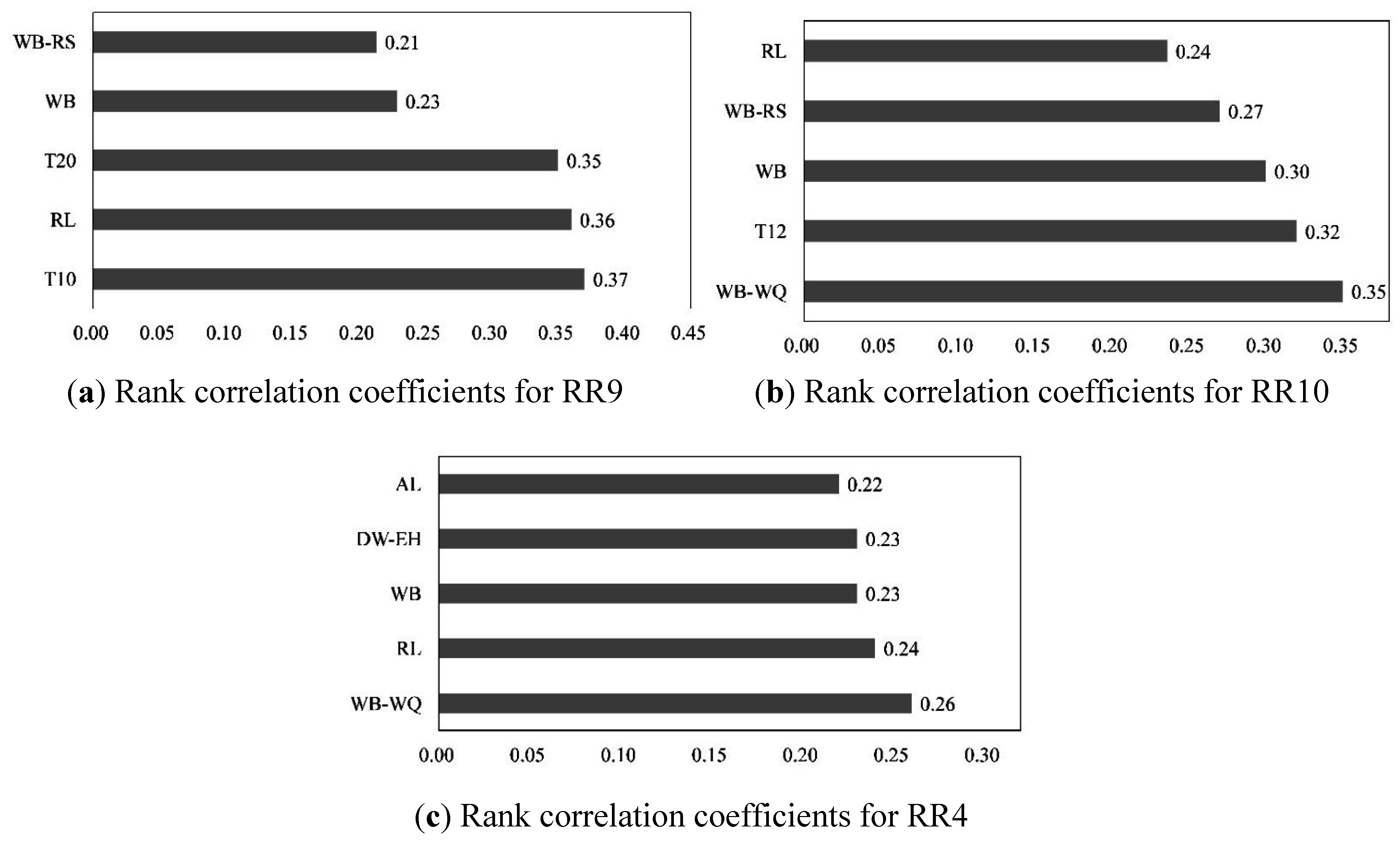Accidental Water Pollution Risk Analysis of Mine Tailings Ponds in Guanting Reservoir Watershed, Zhangjiakou City, China
Abstract
:1. Introduction
2. Methodology and Materials
2.1. Delineation of Risk Sub-Watersheds
2.2. Hazard Analysis of Mine Tailings Ponds
2.3. Vulnerability Analysis of Receptors
| Harmfulness (H) | Reliability (R) | ||
|---|---|---|---|
| Unreliable | Medium | Reliable | |
| High | 10 | 8 | 6 |
| Medium | 8 | 6 | 4 |
| Low | 6 | 4 | 2 |
2.4. Identification of Risk Routes
| Receptors | Grade | Criteria |
|---|---|---|
| Drinking water intakes | 2 | Population served ≤ 50,000 |
| 4 | 50,000 < Population served ≤ 100,000 | |
| 6 | Population served > 100,000 | |
| Irrigating water intakes | 2 | Farming area served ≤ 100 km2 |
| 4 | 100 km2 < Farming area served ≤ 200 km2 | |
| 6 | Farming area served > 200 km2 | |
| Residential land | 2 | Population density ≤ 3500/km2 |
| 4 | 3500/km2 < Population density ≤ 6000/km2 | |
| 6 | Population density > 6000/km2 | |
| Agricultural land | 2 | Green manure crops |
| 4 | Commercial crops | |
| 6 | Food crops | |
| Woodland | 2 | Shrub land |
| 4 | Sparse woodland | |
| 6 | Forest land | |
| Water bodies ** | 2 | Environmental functions at grades IV and V |
| 4 | Environmental function at grade III | |
| 6 | Environmental functions at grades I and II | |
| Nature reserves *** | 2 | Experimental area |
| 4 | Buffer area | |
| 6 | Core area |

2.5. Exposure and Effect Analyses
2.5.1. Dam Failure Modeling
2.5.2. Pollutants Convection-Diffusion Modeling
2.6. Ranking Risk of Sub-Watersheds
2.7. Uncertainty Analysis
2.8. Study Area and Materials
2.8.1. Study Area

2.8.2. Data Sources
3. Results
3.1. The Tailings Pond Pollution Risk Map

3.2. Most Hazardous Tailings Ponds

3.3. Most Vulnerable Receptors

3.4. Significantly Impacted Endpoints

3.5. Uncertainty Analysis


4. Discussion
5. Conclusions
Acknowledgments
Author Contributions
Conflicts of Interest
References
- UNEP. A Guide to Tailings Dams and Impoundments: Design, Construction, Use and Rehabilitation; International Commission on Large Dams: Paris, France, 1996. [Google Scholar]
- Komnitsas, K.; Kontopoulos, A.; Lazar, I.; Cambridge, M. Risk assessment and proposed remedial actions in coastal tailings disposal sites in Romania. Miner. Eng. 1998, 11, 1179–1190. [Google Scholar] [CrossRef]
- World Information Service on Energy Uranium Project. Chronology of Major Tailings Dam Failures. Available online: http://www.wise-uranium.org/mdaf.html (accessed on 25 November 2015).
- Macklin, M.G.; Brewer, P.A.; Balteanu, D.; Coulthard, T.J.; Driga, B.; Howard, A.J.; Zaharia, S. The long term fate and environmental significance of contaminant metals released by the January and March 2000 mining tailings dam failures in Maramures County, upper Tisa Basin, Romania. Appl. Geochem. 2003, 18, 241–257. [Google Scholar] [CrossRef]
- Vick, S.G. Tailings dam failure at Omai in Guyana. Min. Eng. 1996, 48, 34–37. [Google Scholar]
- Hudson-Edwards, K.A.; Macklin, M.G.; Miller, J.R.; Lechler, P.J. Sources, distribution and storage of heavy metals in the Ro Pilcomayo, Bolivia. J. Geochem. Explor. 2001, 72, 229–250. [Google Scholar] [CrossRef]
- Grimalt, J.O.; Ferrer, M.; Macpherson, E. The mine tailing accident in Aznalcóllar. Sci. Total Environ. 2009, 242, 3–11. [Google Scholar] [CrossRef]
- Harder, L.F.J.; Stewart, J.P. Failure of Tapo Canyon Tailings Dam. J. Perform. Constr. Facil. 1996, 10, 109–114. [Google Scholar]
- Azam, S.; Li, Q.R. Tailings dam failures: A review of last one hundred years. Geotech. News 2010, 28, 50–54. [Google Scholar]
- Ministry of Environmental Protection (MEP China). 2015. Explanations of “Guide to Environmental Emergency Plan Making Of Mine Tailings Ponds (Exposure Draft)”. Available online: http://www.zhb.gov.cn/gkml/hbb/bgth/201406/t20140619_277178.htm (accessed on 20 May 2015).
- State Administration of Work Safety (SAWS China). 2014. Mine Tailings Ponds. Available online: http://www.chinasafety.gov.cn/newpage/Contents/Channel_6494/2013/0902/218892/content_218892.htm (accessed on 25 November 2015).
- Rico, M.; Benito, G.; Salgueiro, A.R.; Díez-Herrero, A.; Pereira, H.G. Reported tailings dam failures: A review of the European incidents in the worldwide context. J. Hazard. Mater. 2008, 152, 846–852. [Google Scholar] [CrossRef] [PubMed]
- Pérez-López, R.; Sáez, R.; Álvarez-Valero, A.M.; Nieto, J.M.; Pace, G. Combination of sequential chemical extraction and modelling of dam-break wave propagation to aid assessment of risk related to the possible collapse of a roasted sulphide tailings dam. Sci. Total Environ. 2009, 407, 5761–5771. [Google Scholar] [CrossRef] [PubMed]
- Kossoff, D.; Dubbin, W.E.; Alfredsson, M.; Edwards, S.J.; Macklin, M.G.; Hudson-Edwards, K.A. Mine tailings dams: Characteristics, failure, environmental impacts, and remediation. Appl. Geochem. 2014, 51, 229–245. [Google Scholar] [CrossRef]
- Edwards, R. Toxic sludge flows through the Andes. New Sci. 1996, 152, 4. [Google Scholar]
- Simón, M.; Ortiz, I.; García, I.; Fernández, E.; Fernández, J.; Dorronsoro, C.; Aguilar, J. Pollution of soils by the toxic spill of a pyrite mine (Aznalcollar, Spain). Sci. Total Environ. 1999, 242, 105–115. [Google Scholar] [CrossRef]
- Simón, M.; Martín, F.; Ortiz, I.; García, I.; Fernández, J.; Fernández, E.; Dorronsoro, C.; Aguilar, J. Soil pollution by oxidation of tailings from toxic spill of a pyrite mine. Sci. Total Environ. 2001, 279, 63–74. [Google Scholar] [CrossRef]
- Macklin, M.G.; Payne, I.; Preston, D.; Sedgwick, C. Review of the Porco Mine Tailings Dam Burst and Associated Mining Waste Problems, Pilcomayo Basin, Bolivia. Report to UK Overseas Development Association. Unpublished work. 1996. [Google Scholar]
- Hudson-Edwards, K.A.; Macklin, M.G.; Jamieson, H.E.; Brewer, P.A.; Coulthard, T.J.; Howard, A.J.; Turner, J. The impact of tailings dam spills and clean-up operations on sediment and water quality in river systems: The Ríos Agrio-Guadiamar, Aznalcóllar, Spain. Appl. Geochem. 2003, 18, 221–239. [Google Scholar] [CrossRef]
- Liu, H.; Probst, A.; Liao, B. Metal contamination of soils and crops affected by the Chenzhou lead/zinc mine spill (Hunan, China). Sci. Total Environ. 2005, 339, 153–166. [Google Scholar] [CrossRef] [PubMed] [Green Version]
- Rico, M.; Benito, G.; Díez-Herrero, A. Floods from tailings dam failures. J. Hazard. Mater. 2008, 154, 79–87. [Google Scholar] [CrossRef] [PubMed]
- Mayes, W.M.; Jarvis, A.P.; Burke, I.T.; Walton, M.; Feigl, V.; Klebercz, O.; Gruiz, K. Dispersal and attenuation of trace contaminants downstream of the Ajka bauxite residue (red mud) depository failure, Hungary. Environ. Sci. Technol. 2011, 45, 5147–5155. [Google Scholar] [CrossRef] [PubMed]
- Xenidis, A.; Papassiopi, N.; Komnitsas, K. Carbonate-rich mining tailings in Lavrion: Risk assessment and proposed rehabilitation schemes. Adv. Environ. Res. 2003, 7, 479–494. [Google Scholar] [CrossRef]
- Su, C.L.; Yu, Y.C.; Chang, Y.F. Method of environmental risk assessment on tailings ponds. Environ. Eng. 2009, 27, 74–77. [Google Scholar]
- Liu, R.Z.; Zhang, K.; Zhang, Z.J.; Borthwick, A.G.L. Watershed-scale environmental risk assessment of accidental water pollution: The Case of Laoguan River, China. J. Environ. Inform. 2015. under review. [Google Scholar]
- Landis, W.G.; Wiegers, J.A. Design considerations and a suggested approach for regional and comparative ecological risk assessment. Hum. Ecol. Risk Assess. 1997, 3, 287–297. [Google Scholar] [CrossRef]
- Wiegers, J.K.; Feder, H.M.; Mortensen, L.S.; Shaw, D.G.; Wilson, V.J.; Landis, W.G. A regional multiple-stressor rank-based ecological risk assessment for the Fjord of Port Valdez, Alaska. Hum. Ecol. Risk Assess. 1998, 4, 1125–1173. [Google Scholar] [CrossRef]
- Environmental Protection Agency (US EPA). Framework for Cumulative Risk Assessment. EPA/630/P-02/001F; US EPA: Washington, DC, USA, 2003.
- DoE, U.K. A Guide to Risk Assessment and Risk Management for Environmental Protection; Department of the Environment HMSO: London, UK, 1995.
- Jenson, S.K.; Domingue, J.O. Extracting topographic structure from digital elevation data for geographic information system analysis. Photogramm. Eng. Remote Sens. 1988, 54, 1593–1600. [Google Scholar]
- Liu, R.Z.; Borthwick, A.G.L.; Land, D.D.; Zeng, W.H. Environmental risk mapping of accidental pollution and its zonal prevention in a city. Process Saf. Environ. Prot. 2013, 91, 397–404. [Google Scholar] [CrossRef]
- Ministry of Environmental Protection (China MEP). Technical Guideline for Environmental Risk Assessment of Tailings Pond; China MEP: Beijing, China, 2015.
- State Environmental Protection Agency (China SEPA). Environmental Quality Standards for Surface Water; China SEPA: Beijing, China, 2002.
- State Council of P.R.C. (SC). The Natural Reserve Regulations of P.R. China; China Legal Press: Beijing, China, 1994. [Google Scholar]
- Singh, V.P. Dam Breach Modeling Technology; Springer Science & Business Media: Dordrecht, The Netherlands, 1996. [Google Scholar]
- Xu, Y.Y.; Qiao, Y.A. Several problems on dam breach numerical calculation. Yellow River 1983, 6, 30–33. (In Chinese) [Google Scholar]
- Li, W. Hydraulics Reckoner, 2nd ed.; China Water and Power Press: Beijing, China, 2006. [Google Scholar]
© 2015 by the authors; licensee MDPI, Basel, Switzerland. This article is an open access article distributed under the terms and conditions of the Creative Commons by Attribution (CC-BY) license (http://creativecommons.org/licenses/by/4.0/).
Share and Cite
Liu, R.; Liu, J.; Zhang, Z.; Borthwick, A.; Zhang, K. Accidental Water Pollution Risk Analysis of Mine Tailings Ponds in Guanting Reservoir Watershed, Zhangjiakou City, China. Int. J. Environ. Res. Public Health 2015, 12, 15269-15284. https://doi.org/10.3390/ijerph121214983
Liu R, Liu J, Zhang Z, Borthwick A, Zhang K. Accidental Water Pollution Risk Analysis of Mine Tailings Ponds in Guanting Reservoir Watershed, Zhangjiakou City, China. International Journal of Environmental Research and Public Health. 2015; 12(12):15269-15284. https://doi.org/10.3390/ijerph121214983
Chicago/Turabian StyleLiu, Renzhi, Jing Liu, Zhijiao Zhang, Alistair Borthwick, and Ke Zhang. 2015. "Accidental Water Pollution Risk Analysis of Mine Tailings Ponds in Guanting Reservoir Watershed, Zhangjiakou City, China" International Journal of Environmental Research and Public Health 12, no. 12: 15269-15284. https://doi.org/10.3390/ijerph121214983






